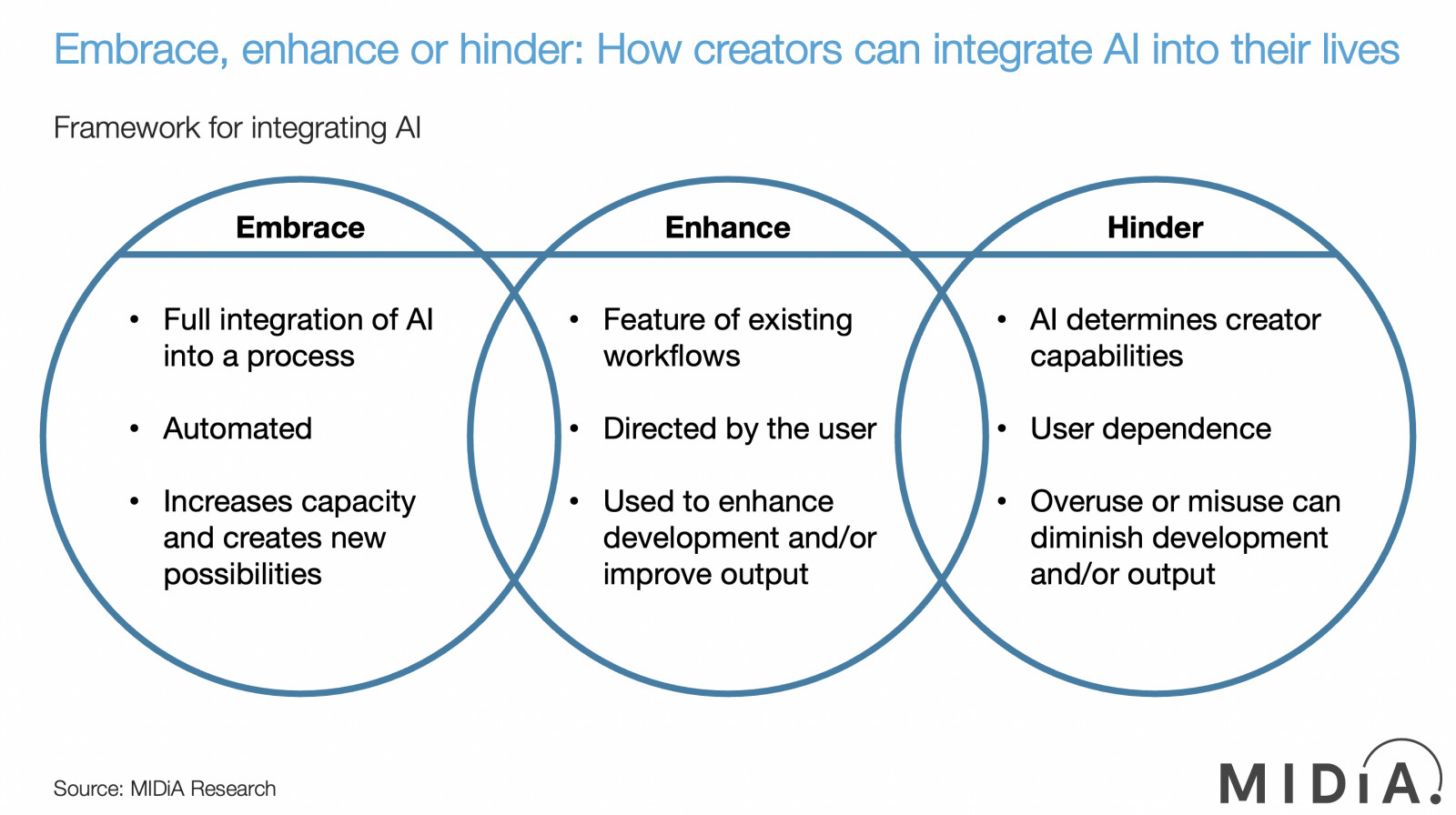Embrace, enhance or hinder: What will AI do for you, the creator?


There has been an abundance of coverage and conversation around AI, and it is unlikely to fade away any time soon. There is a question of how AI will change the music industry and broader creator economy. To start answering it, creators must understand what AI is going to do for them, and decide how deep they lean into it.
There are essentially three options for using any AI tool and the process it is designed for – and it is time to talk about how they will work for you:
Embrace: There are processes where full automation can add more value with human involvement mostly or fully removed. These are processes for which the human mind is vastly inferior to AI, with working through big data being a strong example. In this instance, using AI to extract semi-autonomous insight from large data sets, such as streaming and social data, can lead to steps and manual processes being removed in order to become more efficient.
Enhance: AI does not need to remove humans from the equation to add value. In most use cases, AI is a tool used for enhancing existing processes, and it requires human guidance and input. ChatGPT is a great example – its output becomes more valuable and differentiated by increasing the quality of the input. Particularly with generative AI, this is the difference between asking AI to generate a track for a video (embracing AI) to directing it with briefs and example tracks.
Hinder: Just because a solution has AI in it, does not mean it is the best tool for the job. For example, using AI creator tools is great for helping creators finish and share their music. But there comes a point when using too much AI can begin to diminish the quality of the music – becoming more of an expression of AI than of the artist.
Featured Report
Streaming strongholds High-potential markets for global music players
While the balance of music streamers continues to tip towards global south markets, their smaller ARPU rates limit their revenues. Meanwhile, periodic price-rises and the advent of supremium will reinforce the contributions from the West. This report highlights streaming strongholds, those markets which, underscored by high music engagement and his...
Find out more…What will AI do for you?
Of course, AI will sell and market its benefits, but what about the costs? It would be naive to ignore the trade-offs that using AI brings. And that is exactly why it is important to understand what AI means for you and your circumstances. AI must be situational. To know how to use any tool, but especially AI, you need to look at where you are now and where you want to get to.
Take mixing and mastering, for example. If your goal is to finish the music and simply post it online, then AI mixing and mastering tools are great for you. You may have an unfinished track that you want people to hear, but the obstacle is the mixing and mastering process. You may not be able to afford an engineer nor have the time, so AI is the tool to help you reach your destination.
This is an example of embracing AI. One could argue that AI is being used to replace the mixing and mastering process, but the reality is that there was nothing to replace, since an engineer was never an option to begin with. AI as a process is being fully embraced by the end user as a way of achieving their goal – job done!
Now, say you want to become a mixing and mastering engineer. Using AI tools is going to become part of your repertoire, but you will struggle to get away with simply being an AI button clicker. The expertise you build comes from how you use AI to enhance your workflow and create an even better (or faster) result for your client. Overreliance is when AI becomes a hindrance, not only to the work you are doing but to your own development of your talents.
Only you know you
The same for the above can be said about any part of the creative process, as well as the overall life of being a creator. There is a lot to manage across making music, marketing, performing, practising, admin, finances, etc. There is a clear need for more efficiency across the value chain. AI in all its forms can play a role here. However, the trade-offs of outsourcing must be considered. Being an artist or creator is existing in the business of being talented and differentiated. AI can only do so much to help you with that.
What works as an embrace of AI for some people may become a hindrance for others. Playing in the middle ground of AI enhancement seems like the optimal place to be, but too much demand on people for input across too many channels is going to create AI fatigue among users, turning it into a hindrance. With the increasing demands of modern artistry, it becomes ever more essential to choose the processes to fully outsource, as well as those to avoid using AI entirely.
As more tools become available, creators will have to make choices on what they will do versus what AI will do. By understanding the level of skills and talent you have now, and knowing what kind of creator you want to be, you can make sure that AI fills the gap and does not become it. The most important thing is that AI does not define what the creator does for it. Instead, creators must define what AI does for them.

The discussion around this post has not yet got started, be the first to add an opinion.